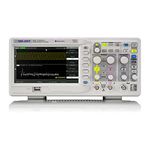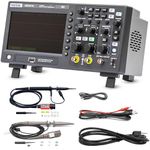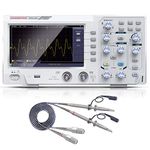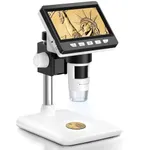10 bestDigital Oscilloscopesof December 2025
112M consumers helped this year.
1
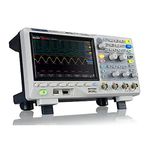
Siglent Technologies SDS1104X-E 100Mhz Digital Oscilloscope 4 Channels Standard Decoder, Grey
Siglent

9.9
2
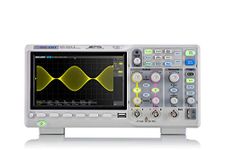
Siglent Technologies SDS1202X-E 200 mhz Digital Oscilloscope 2 Channels, Grey
Siglent

9.8
3
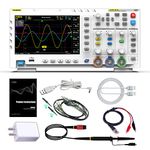
FNIRSI 1014D Oscilloscope - 2 in 1 Digital Oscilloscope DDS Signal Generator 2 Channels 100Mhz Bandwidth 1GSa/s Sampling Rate Built-in 1GB Storage Space
FNIRSI

9.6
8% off
4
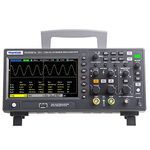
Hantek DSO2D15 2 Channels 150MHz 1GSa/s 8M Memory Oscilloscope with 1CH Waveform Generator
Hantek

9.4
5
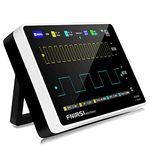
FNIRSI 1013D Oscilloscope - Handheld Tablet Oscilloscope, Portable Digital Storage Oscilloscope 2 Channels 100Mhz Bandwidth 1GSa/s Sampling Rate 7" TFT LCD Touch Screen
FNIRSI

9.3
Other
6

RIGOL DS1202Z 200 Megahertz 2 Channel Digital Oscilloscope Digital Waveform Multimeter Basic Realtime Visualization and Analysis with 7 Inch Display
Rigol

9.1
6% off
7
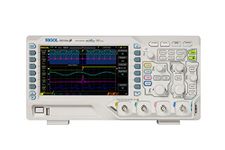
RIGOL DS1054Z Mixed Signal Oscilloscope for Educators and Bench Applications
Rigol

8.8
8
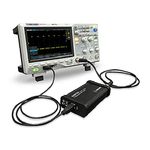
Siglent Technologies SDS2202X-E 200MHz Super Phosphor Oscilloscope
Siglent

8.6
12% off
9
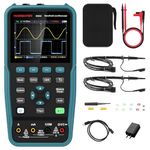
HANMATEK Handheld Digital Oscilloscope 50Mhz Bandwidth with 2 Channels HO52 3.5"TFT Mini Oscilloscope, 2 in 1 Oscilloscope and Multimeter, Backlit Screen, Auto-Calibration Function, Memory Function
HANMATEK

8.4
10
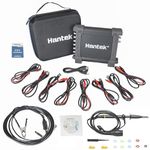
Hantek1008C Hantek 1008C PC USB 8CH Automotive Diagnostic Digital Oscilloscope/DAQ/Programmable Generator

8.1
A Guide to Selecting the Best Digital Oscilloscopes
Choosing a digital oscilloscope can seem overwhelming at first, but understanding your needs and the key specifications will help you make a smart decision. Oscilloscopes are essential tools for visualizing electrical signals, troubleshooting circuits, and learning about electronics. The right oscilloscope for you depends on what kind of signals you want to measure, how fast they change, and how much detail you need to see. By focusing on the main features and matching them to your typical tasks, you can find a model that fits your requirements without paying for unnecessary extras.
Bandwidth
Bandwidth is the range of frequencies the oscilloscope can accurately measure. It determines how fast a signal the oscilloscope can display without distortion. If you work with slow signals, like audio or simple digital circuits, a lower bandwidth is sufficient. For high-speed digital or radio frequency work, higher bandwidth is necessary. Bandwidth is usually divided into segments like entry-level (up to 50 MHz), mid-range (50-200 MHz), and high-end (200 MHz and above). To pick the right bandwidth, choose one that is at least five times higher than the highest frequency you expect to measure. This ensures accurate signal representation.
Sample Rate
Sample rate is how many times per second the oscilloscope captures data points from the signal. A higher sample rate means more detail and accuracy, especially for fast or complex signals. Sample rates are often described in megasamples per second (MS/s) or gigasamples per second (GS/s). For basic work, a lower sample rate is fine, but for capturing sharp edges or glitches, a higher rate is better. As a rule of thumb, the sample rate should be at least ten times the bandwidth. Consider what kind of signals you need to capture—if you need to see fine details, prioritize a higher sample rate.
Number of Channels
Channels refer to how many separate signals you can view at once. Most oscilloscopes have two or four channels, but some have more. If you only need to measure one or two signals at a time, fewer channels are enough. If you often compare multiple signals, such as in digital systems or multi-phase circuits, more channels are helpful. Think about your typical projects—if you often need to see how signals interact, choose more channels; if not, two channels may be sufficient.
Memory Depth
Memory depth is how much data the oscilloscope can store for each capture. More memory allows you to record longer periods of data at high detail, which is useful for analyzing long or complex signals. Memory depth is measured in points or samples. For simple, short signals, less memory is fine, but for capturing rare events or long sequences, more memory is better. If you need to zoom in on details without losing the big picture, prioritize higher memory depth.
Display and User Interface
The display size and quality affect how easily you can read and interpret signals. A larger, clearer screen makes it easier to spot details and compare signals. The user interface, including buttons, knobs, and menus, also impacts how quickly you can set up and use the oscilloscope. If you value ease of use or plan to spend a lot of time with the device, look for a model with a clear display and intuitive controls. If portability is important, a smaller screen may be acceptable.
Connectivity and Storage Options
Connectivity refers to how the oscilloscope can connect to other devices, such as computers or USB drives, for saving data or remote control. Common options include USB, LAN, and sometimes Wi-Fi. Storage options let you save screenshots or data for later analysis. If you need to document your work or share results, good connectivity and storage features are important. If you mostly use the oscilloscope for quick checks, these features may be less critical.
Best Reviews Guide Newsletter
Get exclusive articles, recommendations, shopping tips, and sales alerts
Sign up for our newsletter to receive weekly recommendations about seasonal and trendy products
Thank you for subscribing!
By submitting your email address you agree to our Terms and Conditions and Privacy Policy
